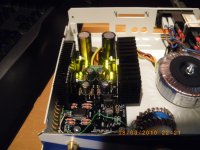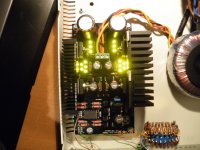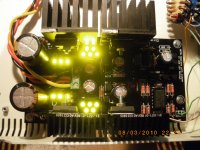Hi, does anybody can tell me where to get the relays (-100).
This type seems to be the better one, but i can't find them.
regards Michael
Both relays specified on the BOM are named as -100. You can get both 12v and 5v from mouser and farnell.
For the 12v one you have parts number 653-G6H-2-100DC12 from mouser and 9949208 from farnell.
Both relays specified on the BOM are named as -100. You can get both 12v and 5v from mouser and farnell.
For the 12v one you have parts number 653-G6H-2-100DC12 from mouser and 9949208 from farnell.
Hi,
the -100 type is more expensive, yet I have not found a hint from manufacturer, ift is definitely better. Has anybody else? What is the difference?
Reichelt supplies the "not -100" part. But you might know this.
Cheers Ernst
From Datasheet:
Standard DPDT G6H-2
High-reliability G6H-2-100
Surface mount G6H-2F
http://www.fek.by/doc/components/L_O/Omron/D20G6H0100.pdf
Thanks today available from Mouser
Standard DPDT G6H-2
High-reliability G6H-2-100
Surface mount G6H-2F
http://www.fek.by/doc/components/L_O/Omron/D20G6H0100.pdf
Thanks today available from Mouser
From Datasheet:
Standard DPDT G6H-2
High-reliability G6H-2-100
Surface mount G6H-2F
http://www.fek.by/doc/components/L_O/Omron/D20G6H0100.pdf
Thanks today available from Mouser
OK. High reliability means, it works under harder conditions or longer under equal conditions. But does that mean, there is any influence in the contact quality, finally in sound quality?
Ernst
OK. High reliability means, it works under harder conditions or longer under equal conditions. But does that mean, there is any influence in the contact quality, finally in sound quality?
Ernst
I suppose it will be both. Components stress makes them to have a shorter life.
For example, a capacitor that will be applied 35v. You could use one rated to 35v or to 50v. The 50v one both will last longer or can work under harder conditions (until theorically 50v)
It's alive! It's alive!
As some of you have suggested, I have upped the default CCS. It does heat the heatsinks quite enought to feel the desire to lift your finger after 10 secs But i don't think they are HOT, after all they are power mosfets prepared to deal with higher temps than my finger. The hottest ones are the ones closer to the relay.
But i don't think they are HOT, after all they are power mosfets prepared to deal with higher temps than my finger. The hottest ones are the ones closer to the relay.
In the CCS resistor (R1), I recommend to put a 2W resistor at least, it get quite hot with that. Better 3w or 4W. Between 9 and 10 Ohm its OK.
I have put in series two 2W resistors achieving a total of 9.6 Ohm. One drops 2.178v, wich means 226mA. The other one drops 1.965 wich means 204mA.
Offsets are -0.82 and -1.54 with inputs shorted. No AC at the output with inputs shorted, wich means no noise at all.
I haven't yet hooked it up to my speakers, so I will listen and tell you later. Here are some pictures I've just taken. Enjoy them.
And try this mod, it works.
As some of you have suggested, I have upped the default CCS. It does heat the heatsinks quite enought to feel the desire to lift your finger after 10 secs
In the CCS resistor (R1), I recommend to put a 2W resistor at least, it get quite hot with that. Better 3w or 4W. Between 9 and 10 Ohm its OK.
I have put in series two 2W resistors achieving a total of 9.6 Ohm. One drops 2.178v, wich means 226mA. The other one drops 1.965 wich means 204mA.
Offsets are -0.82 and -1.54 with inputs shorted. No AC at the output with inputs shorted, wich means no noise at all.
I haven't yet hooked it up to my speakers, so I will listen and tell you later. Here are some pictures I've just taken. Enjoy them.
And try this mod, it works.
Attachments
I have been listening to it for a while, some differents cds of various artists.I'm not very good at critical listening, but I will try to describe what I hear.
Music seems to be more holographic, the spacial sense of the instruments get improved. I play bass too, and I can hear more defined notes, like if the string were there, vibrating in front of you head
In the strings from the guitar happens the same, they apear all around you.
It is very fast too, I have lot of recordings with fast played instruments, and hearing them you can realize every stop, every note after the other. Fast played drums are very defined, every one is in his place and sounding only when they should.
I hope this amateur opinion will encourage you to try this mod. You only need to source some tiny heatsinks and a pair of resistors. And, if you don't notice anything or like it anymore, just swap the older ones in a minute.
Regards
Music seems to be more holographic, the spacial sense of the instruments get improved. I play bass too, and I can hear more defined notes, like if the string were there, vibrating in front of you head
In the strings from the guitar happens the same, they apear all around you.
It is very fast too, I have lot of recordings with fast played instruments, and hearing them you can realize every stop, every note after the other. Fast played drums are very defined, every one is in his place and sounding only when they should.
I hope this amateur opinion will encourage you to try this mod. You only need to source some tiny heatsinks and a pair of resistors. And, if you don't notice anything or like it anymore, just swap the older ones in a minute.
Regards
So I spent more time last night listening to the capacitor mod (see here: cap mod suggestion by salas
The change for me is fairly subtle, but as it seems that voices in particular have changed. I also think it sounds ever so slightly cleaner - kind of the way the very best valve amps do. The other change - the voices bit - it seems that voices stand out and seem more real, better rounded in space. On a few different tracks I tried I got this same result.
Is this what you have observed Salas?
I now have a major itch - what will it sound like if I used 0.33uF instead of 4.7uF......
Fran
The change for me is fairly subtle, but as it seems that voices in particular have changed. I also think it sounds ever so slightly cleaner - kind of the way the very best valve amps do. The other change - the voices bit - it seems that voices stand out and seem more real, better rounded in space. On a few different tracks I tried I got this same result.
Is this what you have observed Salas?
I now have a major itch - what will it sound like if I used 0.33uF instead of 4.7uF......
Fran
After being on all the night, I have noticed in the morning that the heatsinks, specially the smaller ones, are hotter than yesterday. Maybe only because of higher ambient temp. But the fact is that i am feeling concerned about them, now I can't hold my finger for more than 5 secs. Do you think is something to worry about?
Maybe I will try to snap in series another small resistor to lower it a bit. Is really important to hold the CCS between 200 and 250mA to achieve the best performance? Or maybe is more or less the same than, let's say, between 100 and 150mA?
BTW, after a long night listening session, I mantain my first opinion. It sounds stunninly clear and defined, clearly better than before.
Maybe I will try to snap in series another small resistor to lower it a bit. Is really important to hold the CCS between 200 and 250mA to achieve the best performance? Or maybe is more or less the same than, let's say, between 100 and 150mA?
BTW, after a long night listening session, I mantain my first opinion. It sounds stunninly clear and defined, clearly better than before.
Gordon Holt offered a number of great observations, one of them
being (paraphrased) "You can hear everything that is done to
the signal"

Is he still alive? A most succinct man.
I forgot to say that, despite the extremely low offsets of -0.82mv and -1.54mv in the output of the DCB1, it's only caused by termal drift.
I saw that by blowing a bit over the board. You can see falling down the numbers in the DVM until 0, and then it increases in the opposite polarity.
So you made a PERFECT circuit guys, in depends ONLY of the components drift. The circuit can't be bettered itself.
I saw that by blowing a bit over the board. You can see falling down the numbers in the DVM until 0, and then it increases in the opposite polarity.
So you made a PERFECT circuit guys, in depends ONLY of the components drift. The circuit can't be bettered itself.
Just for information to some of you guys, I bought 100 led to match them for the Shunt Reg and out of the 100, this is what I got:
Led YEL, Mouser 593-VAOL-3HCE4
Tested using 9V supply, 1K resistor
DVM FLuke 87, 4-1/2 digits meter
Led-Vf QTY
1.91V = 5
1.92V = 1
1.93V = 32
1.94V = 53 (Most 1.936-1.937V)
1.95V = 8
1.96V = 2
Led YEL, Mouser 593-VAOL-3HCE4
Tested using 9V supply, 1K resistor
DVM FLuke 87, 4-1/2 digits meter
Led-Vf QTY
1.91V = 5
1.92V = 1
1.93V = 32
1.94V = 53 (Most 1.936-1.937V)
1.95V = 8
1.96V = 2
- Home
- Amplifiers
- Pass Labs
- Building a symmetrical PSU B1 buffer



 is good for the glowing shunties. As for the polar bear...
is good for the glowing shunties. As for the polar bear... Now that you surely got the ''best cap there'' itch
Now that you surely got the ''best cap there'' itch